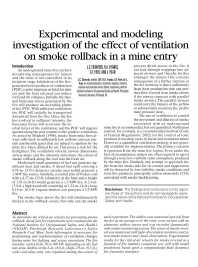Mining Publication: Experimental and Modeling Investigation of the Effect of Ventilation on Smoke Rollback in a Mine Entry
Original creation date: January 2006
To determine the critical air velocity for preventing smoke rollback, diesel-fuel fire experiments were conducted in the NIOSH Pittsburgh Research Laboratory's Safety Research Coal Mine. Such information is necessary for preplanning and implementing ventilation changes during mine firefighting and rescue operations. The fire intensity varied from 50 to 300 kW depending on the fuel tray area. Airflow in the 6.6-ft-high, 9.5-ft-wide coal mine entry was regulated during the course of each experiment. The airflow was measured upwind from the fire as an average over the entry cross-section with an ultrasonic airflow sensor and was recorded dynamically with a mine monitoring system. The extent of smoke reversal was monitored with light-obscuration monitors, ionization smoke sensors, and visual observations. Experimental results for the critical air velocity for smoke reversal as a function of fire intensity compared very well with model predictions based on a computational fluid dynamics (CFD) fire dynamics simulator.
Authors: JC Edwards, RA Franks, GF Friel, L Yuan
See Also
- CFD Analysis of Mine Fire Smoke Spread and Reverse Flow Conditions
- CFD Modeling of Fire Spread Along Combustibles in a Mine Entry
- Evaluation of the Bagged Stone Dust Barrier Effectiveness in a Bord and Pillar Mine
- Evaluation of the Relative Importance of Coalbed Reservoir Parameters for Prediction of Methane Inflow Rates During Mining of Longwall Development Entries
- Experimental and Modeling Investigation of the Effect of Ventilation on Smoke Rollback in a Mine Entry
- Novel Stopping Designs for Large-Opening Metal/Nonmetal Mines
- Reservoir Modeling-Based Prediction and Optimization of Ventilation Requirements During Development Mining in Underground Coal Mines
- Smoke, Carbon Monoxide, and Hydrogen Chloride Production from the Pyrolysis of Conveyor Belting and Brattice Cloth
- Study of Mine Fires and Mine Ventilation: Part I, Computer Simulation of Ventilation Systems Under the Influence of Mine Fires
- Understanding Mine Fire Disasters by Determining the Characteristics of Deep-Seated Fires
- Content source: National Institute for Occupational Safety and Health, Mining Program


 ShareCompartir
ShareCompartir
